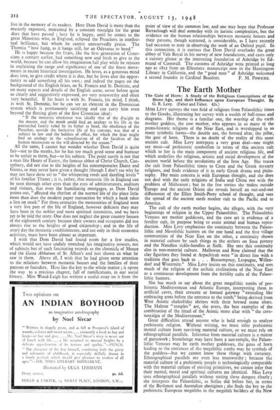The Earth Mother
The Gate of Horn : A Study of the Religious Conceptions of the Stone Age, and their Influence upon European Thought. By G. R. Levy. (Faber and Faber. 42s.)
MIss LEVY surveys the vast field of religions from Palaeolithic times to the Greeks, illustrating her survey with a wealth of half-tones and diagrams. Her theme is a familiar one, the worship of the earth mother goddess, the cow mother, who appears in so many of the proto-historic religions of the Near East, and is worshipped in so many symbolic forms—the double axe, the horned altar, the pillar, the gate of horn. There is no doubt of the reality of this most ancient cult. Miss Levy interprets a very great deal—one might say most—of prehistoric symbolissm in terms of this ancient cult which to her is the main component of ancient religious life, and which underlies the religious, artistic and social development of the ancient world before the revolutions of the Iron Age. She traces the cult from Palaeolithic' times to Crete and the Greek mystery religions, and finds evidence of it in early Greek drama and philo- sophy. Her main concern is with European thought, and she does not deal with the early religions of India and China nor with the „problem of Mithraism ; but in the few sorties she makes outside 'Europe and the ancient Orient she reveals herself an out-and-out diffusionist of the Elliot Smith-Perry school of thought, and sees the spread of the ancient earth mother cult to the Pacific and to America.
The cult of the earth mother begins, she alleges, with the very beginnings of religion in the Upper Palaeolithic. The Palaeolithic Venuses are mother goddesses, and the cave art is evidence of a fertility cult, its purpose being to assist animal and human repro- duction. Miss Levy emphasises the continuity between the Palaeo- lithic and Mesolithic hunters on the one hand and the first village communities of the Near East on the other, a continuity shown in material culture by such things as the archers on Susa pottery and the Nanffian sickle-handles at Sialk. She sees this continuity also in non-material culture. Mallowan and Rose claimed that the clay figurines they found at Arpachiyah were "in direct line with a tradition that goes back to . . . Brassempouy, Lespugue, Willen- dorf and Wisternitz." Miss Levy insists on this continuity, and sees much of the religion of the archaic civilisations of the Near East as a continuous development from the fertility cults of the Palaeo- lithic hunters.
She has much to say about the great megalithic tombs of pre- historic Mediterranean and Atlantic Europe, interpreting them as artificial caves, their crescent or horned gateway "extending like embracing arms before the entrance to the tomb," being derived from West Asiatic chalcolithic shrines with their horned stone altars. The Maltese " temples " are, she avers, the best examples of the combination of the ritual of the Asiatic stone altar with "the cave- nostalgia of the Mediterranean." - Great difficulties attend anyone who is bold enough to analyse prehistoric religion. Without writing, we must infer prehistoric mental culture from surviving material culture, or we must rely on ethnographical parallels. Inference from material culture is a matter of guesswork ; Stonehenge may have been a sun-temple, the Palaeo- lithic Venuses may be earth mother goddesses, the gates of horn leading to the entrances of the megalithic tombs may be symbols of the goddess—but we cannot know these things with certainty. Ethnographical parallels are even less trustworthy ; because the material culture of a prehistoric people is technologically comparable with the material culture of existing primitives, we cannot infer that their mental, moral and spiritual cultures are identical. Miss Levy uses ethnographical parallels without stating these dangers clearly ; she interprets the Palaeolithic, as Sollas did before her, in terms of the Bushmen and Australian aborigines ; she finds the key to the prehistoric European megaliths in the megalith builders of the New Hebrides desctibed by Deacon and Layard. Yet there is no proved or necessary connection between all people who use large stones in the technological expression of their religion ; the stone men of Malekula may be no guide to the stone men of Malta and Carnac. Miss Levy's passionate devotion to her main theme allows of no alternative interpretations ; these will occur to her readers who cannot see the early development of religious life as the flowering of a single earth mother cult. But she has amassed and published' in attractive form a great quantity of facts about early religions which will be of value even to those who cannot share her faith in the all-embracing earth mother. It seems to me likely and true that in prehistoric times, as in these days, there are many ways to heaven, and the Gate of Horn leads to only one of them.
GLYN E. DANIEL.



































 Previous page
Previous page